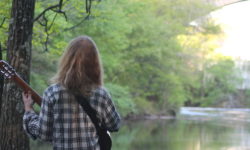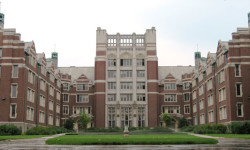[ccfic caption-text format="plaintext"]
With the recent reopening of Cook’s Bridge linking Needham’s Central Avenue with Newton’s Elliot Street, a plan to repair a second bridge over the Charles River linking the two communities has now moved forward for consideration.
Last fall, Needham and Newton residents formed the Echo Bridge Railing Committee to focus public and private resources to work with the Massachusetts Water Resources Authority (MWRA), owner of the iconic Echo Bridge, to seek Community Preservation Act (CPA) funding for an in-kind reconstruction of the 140-year old cast-iron railings now obscured by temporary chain link fencing installed in 2008 for safety reasons. The establishment of the Committee was in response to an earlier railing proposal by MWRA during the late summer.
Plans to advance the historic railing reconstruction took a big step forward with two approvals: one from the Needham Historical Commission on November 21, and one by the Newton Upper Falls Historic District Commission two weeks earlier. MWRA and Committee members worked together to develop a Railing Reconstruction Plan based on a 2007 study by the preservation planning firm McGinley, Kalsow & Associates.
“I encourage folks in Needham to visit Echo Bridge this month so they can be reminded of how beautiful a walk it is and how pressing is the need for railing reconstruction,” said Jeff Heller, member of the Needham Historical Commission and member of the Railing Committee.
Echo Bridge was built in 1876 to carry water to the growing City of Boston and now serves as a back-up water supply, last used in 2010. Both Echo Bridge and the Sudbury Aqueduct, which is housed inside the Bridge, are structurally sound, and the water supply for metropolitan Boston is safe and secure. Therefore, with total project cost estimated at $1.44 million, MWRA could not justify dedicating ratepayer dollars to fully fund a reconstruction of the historic railings.
The Committee concluded that there were two ways to generate support for sharing the cost for reconstructing the railings with the MWRA:
1) MWRA would apply to both Newton and Needham for CPA funding, and
2) The Railing Committee would launch a private capital fundraising campaign, of which $100,400 has already been pledged.
On December 14, the Needham CPC voted that the MWRA’s Echo Bridge Historic Railing Reconstruction Project is eligible for CPA funding, which is the first step in the process of deliberations for the 2017 planning cycle. Also in December, the Newton Community Preservation Committee voted to invite a full proposal for the project for its consideration.
“As the Echo Bridge Railing Committee launches our public awareness and pledge drive, we aim to secure hundreds of pledges by mid February from Needham and Newton residents who are fond of Echo Bridge and value its preservation,” said Lee Fisher, chairman of the Committee. “We need pledges both large and small in order to show the Needham Community Preservation Committee that this project has both wide spread support within the Town and a significant commitment of private funds to leverage potential CPA funding,” he emphasized.
The Echo Bridge Promenade is one of the best kept secrets in metropolitan Boston. This multi-use pathway, linking Newton and Needham since 1876, offers dramatic views of the Charles River as it drops over the nearby falls and winds its way through Hemlock Gorge.
“With these railings in such dire need of attention, it is so important for all entities to come together, as they did in reconstructing the Central Ave/Elliot St bridge, to commit to a historically accurate replication of the railings,” said former Needham Selectman Jack Cogswell. “Another temporary fix to this long-neglected need would be short-sighted,” he added.
Echo Bridge's handsome granite and brick design contributes to the rugged beauty of surrounding Hemlock Gorge, one of the first of five parks acquired by the Metropolitan Park Commission in 1893. The bridge is on the National and State Registers of Historic Places and it is the second longest masonry arch on the continent. Once a major tourist destination, it continues to serve as a popular spot for hikers, artists and nature lovers and as a transportation corridor.
“Echo Bridge represents a period in American history where civil engineering projects to build waterworks and span rivers provided the infrastructure needed to support the growing country, while remaining aware of the aesthetic impact of public structures,” said Joe Hunter, Assistant VP at Olin College and a director of the Needham Historical Society. “Now we have an opportunity to enhance this incomparable public resource in our towns that provides, to this day, transportation and recreational benefits to our residents.”
For additional information about the Echo Bridge railing campaign, visit www.EchoBridgeRailings.com.























